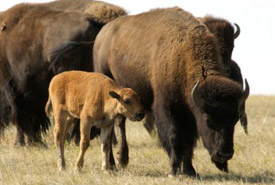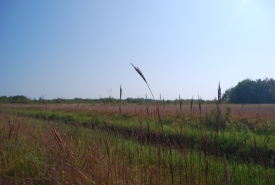New Manitoba emblems reflect the province's natural heritage

Plains bison (Photo by Karol Dabbs)
On June 10, 2014, three new emblems received Royal Assent to be amended to The Coat of Arms, Emblems and the Manitoba Tartan Act.
Big bluestem was chosen as Manitoba’s Official Grass emblem, plains bison as Manitoba’s Official Mammal and walleye as Manitoba's Official Fish. The addition of these emblems reflects the importance of our natural heritage.
Big bluestem used to inhabit the vast lands of Manitoba’s prairies. It supports complex ecosystems and many endangered species that are native to Manitoba. Historically, animals such as plains bison used big bluestem as a food source. The roots of this native grass helps prevent soil and wind erosion, and provide forage and wildlife shelter. Big bluestem grows 30-60 inches tall and its roots spread 12 feet in depth in the tall grass prairie. Today, the tall grass prairie has been reduced to less than half of one percent of its former range due to agriculture and development. It is now an endangered natural system.

Big bluestem, Tall Grass Prairie, Manitoba (Photo by NCC)
The plains bison is one of the most recognizable symbols used in Manitoba. It can be found in Manitoba’s provincial flag and Manitoba’s Legislature. Hundreds of bison used to graze thousands of miles in the great plains. The plains bison was an important element in the livelihood of the Indigenous people in Manitoba, who used the animal for a variety of uses including food, shelter, clothing, medicinal purposes and tools. Sadly, overhunting reduced the population of the plains bison and by the early twentieth century they were all but extinct.
The walleye was chosen as Manitoba’s Official Fish due to its popularity and abundance in the waters in Manitoba. The largest population of walleye resides in the deep and cool waters in Manitoba. Walleye provide a great challenge for fishing enthusiasts and a great treat for an easy lunch.
Big bluestem, plains bison and walleye join prairie crocus, great grey owl and white spruce as Manitoba’s emblems, which continue to represent the great history and unity in Manitoba. These emblems will inspire awareness for the environment and the species that depend on it.
Editor's note, Aug 25, 2014: The Nature Conservancy of Canada (NCC) has a direct connection to Manitoba's new Official Grass emblem. Two NCC staff, Julie Sveinson Pelc and Cary Hamel, played a lead role in helping to get big bluestem chosen as Manitoba's Official Grass emblem. Envious of their provincial neighbours in Saskatchewan and Alberta, who already had their own prairie grass emblems, Sveinson Pelc and Hamel created the website Vote for Manitoba's Grass Emblem and travelled to various community events where they invited citizens to cast their votes for one of four candidate grasses, including big bluestem.


